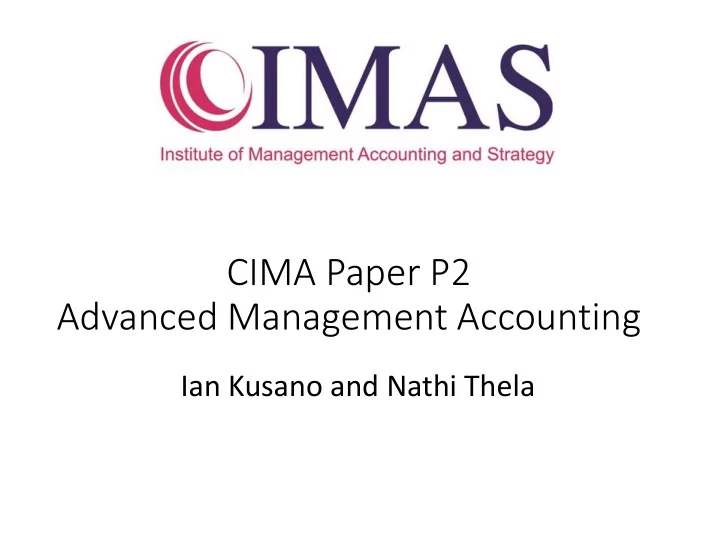

CIMA Paper P2 Advanced Management Accounting Ian Kusano and Nathi Thela
6 Chapter Performance Measures & Budgetary Control 1
Learning Objectives Lead B1: Discuss decision making in responsibility centres Component B2a): Prepare reports for the evaluation of projected and actual performance -Key metrics for the assessment of financial consequences including profitability, liquidity and asset turnover ratios, return on investment, residual income and economic value. -Analysis of reporting by dimension (e.g. segment, product, channel.) 2
Performance Evaluation An organisation should have certain targets for achievement. Targets can be expressed in terms of key metrics. It is a basis for analysing performance (both budgeted and actual). Actual performance should then be assessed in comparison with the targets. The term ‘key performance indicators’ might be used. 3
Performance Evaluation Key areas of financial performance are: • Profitability -ROCE = Profit/Turnover x Turnover/Capital Employed = Profit/Capital Employed • Liquidity – Quick Ratio -Current Asset • Asset turnover -Working Capital Ratios -Asset turnover • Shortcoming of Financial Indicators • Non-Financial Performance Indicators 4
Divisional Performance Measurement ROCE RI EVA ROCE RI EVA = = = Profit – Imputed NOPAT – Earning Before Interest and Tax Interest Charge Capital Charge x 100 Capital Employed Imputed Interest Charge = Capital Employed X Cost of Capital
ROCE Advantages Disadvantages Widely used and accepted Dysfunctional behaviour when projects with lower ROI are turned away Enables comparisons Different accounting policies between divisions and can confuse comparisons companies of different sizes Can be broken down into ROCE increases artificially secondary ratios for more with age of assets, thus detailed analysis discouraging investment
Example 1 Nielsen Ltd has 2 divisions with the following information: Division A Division B $ $ Profit 90,000 10,000 Capital Employed 300,000 100,000 ROCE 30% 10% Division A has been offered a project costing $100,000 and giving returns of $20,000. Division B has been offered a project costing $100,000 and giving returns of $12,000. The company's cost of capital is 15%. Divisional performance is judged on ROCE and the ROCE-related bonus is sufficiently high to influence the managers' behaviour. 1. What decisions will be made by management if they act in the best interests of their division (and in the best interest of their bonus)? 7
Example 1 2. What should the managers do if they act in the best interests of the company as a whole? 8
ROI Advantages Disadvantages Reduces ROI’s problem of rejecting Does not facilitate comparisons projects with an ROCE in excess of between divisions the company’s target but lower that the division’s current ROCE The cost of financing a division is Does not relate the size of a brought home to divisional division’s profit to the assets managers employed in order to obtain that profit. Can be broken down into secondary ratios for more detailed analysis
Residual Income Advantages Disadvantages It reduces ROCE's problem of Does not facilitate comparisons between divisions rejecting projects with an ROCE in excess of the company's target, but lower than the division's current ROCE. The cost of financing a division is Does not relate the size of a brought home to divisional division's profit to the assets managers employed in order to obtain that profit
Example 2 An investment centre has net assets of $800,000, and made profits before interest of $160,000. The notional cost of capital is 12%. An opportunity has arisen to invest in a new project costing $100,000. The project would have a four-year life, and would make cash profits of $40,000 each year. Required: 1.What would be the average ROI with and without the investment? Would the investment centre manager wish to undertake the investment if performance is judged on ROI in Year 1? 2.What would be the average annual residual income with and without the investment? Would the investment centre manager wish to undertake the investment if performance is judged on residual income in Year 1? 11
EVA Similar to RI, but accounting profit is adjusted for economic depreciation and advertising / Development costs; and net assets are valued at replacement cost ECONOMIC PROFIT (Net Operating Profit After Tax) $X Less : Capital charge (net assets x cost of capital) ($X) EVA $X Advantages of EVA • A performance measure that attempts to put a figure to the increase, or decrease, which should have arisen during a period from the operations of a company or individual divisions within a company. • Can be measured for each financial reporting period. • Based on economic profit and economic values of assets, not accounting profits and asset values. • Easily understood by non-accountants.
Example 3 A division has a reported annual profit of $27m. This was after charging $6m for the development and launch costs of a new product which is expected to have a life of 3 years. The division has a risk adjusted cost of capital of 10% per annum, but it has a large bank loan, which incurs annual interest charges of 8%. The net book value of the division's net assets is $85m. The replacement cost of the assets is estimated to be $96m. Ignore the effects of taxation. Calculate the division's EVA. 13
Recommend
More recommend